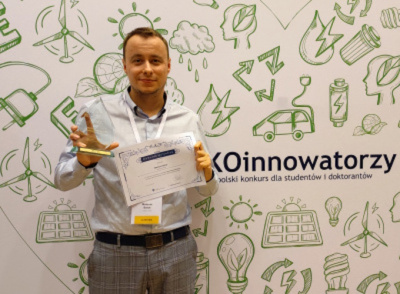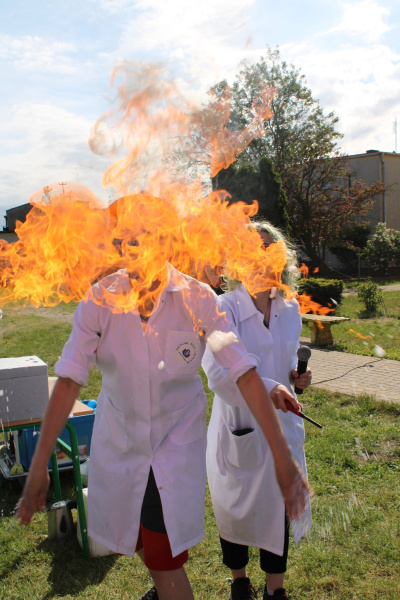
‘During the inaugural meeting, which took place the day before the Start scholarship award ceremony, we were told not to rest on our laurels and not to settle for the one peak we had managed to climb, because there are more than one eight-thousanders in the world. These words stuck in my mind,’ says mgr Mateusz Baluk, from the Faculty of Chemistry at the University of Gdańsk.
- What is it like to be one of the most talented young scientists in Poland?
- At first, I felt honoured. However, when I arrived at the integration meeting, which took place just before the award ceremony, I saw that there were many more promising young scientists like me. So I am just an ordinary PhD student who is simply doing his job.
During this meeting, we were told not to rest on our laurels and not to settle for the one peak we had managed to reach, because there are more than one eight-thousander in the world. These words stuck in my mind.
I admit that all the projects I submitted to the Foundation for the Advancement of Science in Poland when applying for the Start scholarship were a bit off-topic. I do not limit myself to an individual research plan, but take an interdisciplinary approach to the materials I work on. If the material produced is inactive in the photocatalytic reactions I primarily deal with, I investigate where else it can be utilised. This approach could potentially lead to the development of a patent and the initiation of larger-scale activities.
- So, the first eight-thousander has been conquered. What are your plans for the future?
A few days after receiving the scholarship, I found out that my project ‘Green Infinity: Multi-Mix-MOF born from PET for the production of solar fuels’ had received funding from the National Science Centre as part of the OPUS 29 competition in the amount of PLN 2.2 million. This came as a huge surprise to me, because from what I had heard, I am the first PhD student from the University of Gdańsk in the history of ‘Opus’ to receive such funding.
At the same time, I would like to thank my supervisor, prof. Adriana Zaleska-Medynska, who showed me the application of nanomaterials and porous materials in photocatalysis and involved me in various research and development projects that strengthened my scientific achievements.
- Your research has applications in air purification. This is a very important topic, considering that approximately 40,000 people die each year in Poland due to smog. So let's imagine that every year Łowicz or Żory disappears from the map of Poland.
- Humans produce pollution - that is a fact. We must avoid generating it, eliminate it by all means - or, like me, produce materials, optimise them and search for new methods of waste degradation or the production of new renewable raw materials.
Although most of my research is basic research, I am currently working on patent applications.
Recently, I participated in a research and development project (as part of the Innovation Incubator programme), in which my team and I developed useful sorbents in the form of tablets based on metal-organic frameworks (MOFs), i.e. porous materials composed of coordinated metal ions and organic linkers, which, when combined, form scaffolding-like structures. Such materials can be used to purify biogas from carbon dioxide or hydrogen sulphide or as a sorbent for other pollutants from gas streams.
I am currently involved in work (as part of a project funded by a PRELUDIUM grant) on the production of thin films - titanium dioxide nanotubes modified by MOFs. Ultimately, I use these materials to produce useful fuels, such as methanol, methane or formic acid, as a result of the photoreduction of carbon dioxide. And what I will be doing next (as part of recently received funding from the OPUS programme) is obtaining MOFs from waste PET (bottles or other plastics) and using these materials for photogeneration of hydrogen.
- What makes these projects so special that you are applying for a patent?
- I create materials based on carbon and various metals which, thanks to their unique selective gas absorption properties, absorb carbon dioxide. Such materials can be used in the purification of biogas, which will increase its calorific value thanks to the reduction of CO2.
To put it simply, after passing biogas through the separators and purifying it of carbon dioxide, more energy will be generated from the combustion of the purified biogas, because it is important to remember that CO2 cannot be burned and therefore has no calorific value. I should mention that research on these materials was awarded third place in the first edition of the Young Fahrenheit competition as the best project for commercialisation.
- What are you working on as part of your doctoral thesis?
- I mainly create porous materials based on titanium or hybrids of these materials, such as titanium oxide (IV) with titanium MOFs for photocatalytic reactions.
I use titanium-based porous materials or hybrid materials with metal oxides (e.g. titanium oxide or copper oxide) for reactions in which the material is excited under the influence of radiation quanta (e.g. sunlight). Such excited material exhibits specific properties that can be used to remove pollutants, convert carbon dioxide into useful fuels, or generate hydrogen (green fuel).
- Why did you become involved in environmental protection?
- In the city where I come from, air pollution is quite high and I found it difficult to cope with its effects. I have always been interested in nanomaterials and during my studies I began to obtain nanomaterials that could be easily and quickly used to remove pollutants from the air.

Fot. Archwium prywatne
- You are also involved in popularising science, for which you have received numerous awards and distinctions.
- At the beginning of my studies, I joined the Scientific Circle of Chemists at the University of Gdańsk, and that's how my adventure with popularising science began. For me, it's a combination of science and fun, and a way of showing in a simple way that chemistry isn't so bad.
I quickly caught the bug and started getting involved in other activities that showed the achievements of science in an accessible way. As a PhD student, as part of the National Representation of Doctoral Students, I got involved in organising the Popularyzacja Nie boli (Popularisation Doesn't Hurt) competition. The group I mentored won third place in the competition. I participated in the dissemination of the Studia na migi (Studies in a Nutshell) campaign and was involved in popularising new solutions for young people who are just entering adulthood. My greatest achievement in the field of popularisation is being a finalist in the national competition Popularyzator Nauki 2023 (Science Populariser 2023), organised by PAP and the Nauka w Polsce (Science in Poland) portal.
- One of your activities related to the popularisation of science was recording a video on how to build a solar cell using blackberry juice.
- On the occasion of the Chemistry Department's Open Day, my colleagues from the department and I decided to prepare something original, and since it was the middle of the pandemic, we decided to record a video. We used blackberry juice as a dye to obtain a photovoltaic cell that ‘captures light’ and generates electricity.
It's a shame we couldn't present our experiment live and I couldn't see the students' reactions, because, as lofty as it may sound, it was for the smile of understanding on a young person's face that I got involved in popularising science.
I never saw any experiments like this when I was a child. When I was 10, I took part in a first aid demonstration. That was it. I lived on the outskirts of a small town, so that's probably why I had fewer opportunities to participate in various activities.
At the next stages of my education, my chemistry teacher in middle school showed us a dozen or so simple experiments related to the properties of metals, acids and bases. More complicated experiments in high school were just a dream. So my imagination had to work hard to imagine and remember various chemical reactions.
- How did you come to choose chemistry?
- I always wanted to be a chemistry teacher. I was ‘the best’ in my class in high school in this subject - not only because I got the best grades, but because I simply understood it. And I understood it because I learned by teaching someone else. And that's how it stayed.
It was similar at university. Before tests, I tried to explain individual topics to others, and the more I explained to others, the better I understood the complexities of physical, theoretical and analytical chemistry.
I already knew in secondary school that I wanted to pursue a career in teaching chemistry. My chemistry teacher, who inspired my love for this field of science, studied in Gdańsk. I thought it would be wonderful to live and study by the sea.
When I started my studies, I knew that I wanted to be a chemistry teacher, but already in my first year I realised that I wanted to stay at the university. That is why I started to cover a wider range of material than other students. From the second year of my studies, I also started working as a researcher at the Department of Environmental Technology, where I am now. And I am still here.
- But you're not giving up on popularising science?
- I admit that my research work has absorbed me and I am focusing on implementing new projects, research and tasks, but I try not to give up on popularising science - I try to do this on social media, for example.
It is very difficult because science popularisers have to compete for an audience with materials intended solely for entertainment, not for expanding knowledge. In addition, I am happy to get involved in events organised not only at our university.
Whenever I can, I try to sneak elements of science popularisation into my classes with students. For example, last summer, a group of students and I built a prototype of a hydrogen-producing power plant of the future. But in addition to typical scientific research and the construction of a prototype device for generating hydrogen from seawater, we promoted our project's solutions and renewable technology in primary schools, at conferences and on social media.
I should mention that it is sad that people who are involved in popularising science usually do so on a voluntary basis, because unfortunately in our country, science populariser is still not an official profession. I would like to appeal for this profession to be registered and for scientists who popularise science to be supported if they do it well.
- What are your passions? What do you do outside of your scientific life?
- My escape is the popularisation of science. Currently, as part of the National Representation of Doctoral Students, I record podcasts in which I interview doctoral students from all over Poland about how to prepare a dissertation, what problems universities face and what advice they have for young and future doctoral students.
I think that being a scientist is not a job, but a lifestyle, because I increasingly find myself thinking almost constantly about my work, about what could be done differently, better, further. It's not like I finish my research, leave work and immediately stop thinking about it. Quite the opposite. I'm constantly analysing, wondering if I'll achieve the desired effect, or if it might be better to change a parameter. Everyday life outside the university can be an inspiration for further research. When you're involved in science, you have to be curious about the world - otherwise, you can quickly burn out.
